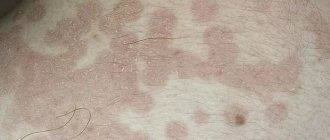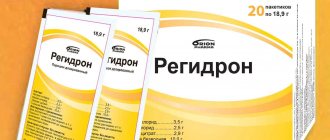When to sound the alarm
A child’s immune, digestive and nervous systems are naturally imperfect.
The formation of defensive responses occurs before adolescence. Gagging reflexes are a normal reaction of the baby's body when he is in danger. A child vomits due to overeating or poor nutrition, force-feeding, high temperature, stress, increased activity of nerve endings, and fear. Vomiting during ARVI and food poisoning is a natural reaction to intoxication. This way, the developing digestive tract reduces the load on the body, relieving it of the need to digest food. Occasional (one-time) vomiting in a child in response to an irritant is normal. In this case, there is no need to take medications.
Regular and uncontrollable vomiting in children of any age is a reason to consult a doctor. The reflex can be a symptom of serious intoxication, diseases of the nervous or digestive system. You should call an ambulance or take your child to the clinic yourself if:
- vomiting occurred due to a fall or a blow to the head;
- accompanied by elevated temperature;
- the child vomits repeatedly (after every meal or regardless of food);
- there is diarrhea or constipation, headache, weakness, drowsiness;
- the vomit contains impurities of blood, bile, mucus, pus or is colored dark brown;
- gagging occurs for several days in a row without other symptoms.
Children under 1 year of age should be seen by a doctor, as vomiting is especially dangerous for them. A young child quickly develops dehydration, which is life-threatening.
Is it possible to stop a child from vomiting?
Very often, vomiting in a child frightens parents, and they try to stop it by any means. Indeed, medications that can stop this process exist, but we need to figure out whether it needs to be stopped at all. In most cases, vomiting is a protective mechanism that helps cleanse the body of harmful substances . If we “turn off” it with the help of a medicine, this will only increase the intoxication of the body and the child’s condition will quite logically worsen.
The child feels the urge to vomit
Why then do antiemetics exist? Such medications should only be used under medical supervision and when absolutely necessary. For example, young children with rotavirus infection may experience uncontrollable vomiting, which leads to severe dehydration. In such a situation, the use of an antiemetic is considered acceptable. But this is by no means a cure for the disease, but a temporary measure that helps alleviate the patient’s condition until his body overcomes the infection.
Is it possible to give medications?
Any medications must be prescribed by a doctor. Self-treatment of childhood vomiting leads to a weakening of other symptoms and complicates the identification of the cause of the disorder. A parent can give medicine if he knows exactly what caused the reflex (and that it does not threaten health):
- against the background of elevated body temperature - antipyretics;
- consuming foods that are difficult for the child to tolerate - enzyme preparations;
- stress – children's sedatives;
- motion sickness – medications for vestibular disorders;
- consuming large quantities of some product - sorbents.
Intestinal infections, intoxications, and viral diseases of the gastrointestinal tract should be treated by a doctor. When consuming poisons and toxins, gastric lavage is necessary before starting treatment. It must be done in a hospital, since delay or illiterate behavior of parents poses a danger to the child’s life.
Drugs such as Metoclopramide, Cerucal, Ondansetron cannot be given to a child at his own discretion, regardless of his age. The drugs stop the gag reflex at the level of the nerve center in the brain. Sometimes this slows down the process of removing toxins from the body.
The drugs that every parent should give their child when vomiting are saline solutions (rehydrants). They prevent dehydration and possible complications of vomiting. Saline solutions should be given immediately after the reflex occurs, until hospitalization or medical examination, and during the period while the child is vomiting.
Principles and methods of treatment
The treatment method will depend on the diagnosis and the general condition of the baby. In such cases the following applies:
- Drugs from the group of sorbents (Smecta, Activated carbon, Polyphepan, Enterosgel, etc.) They are prescribed for poisoning and disorders, and are sometimes used as an adjuvant therapy for intestinal infections.
- Antiemetics such as No-Spasm, Motilium or Cerucal are prescribed in severe cases when vomiting does not stop for a long time. They have some side effects, so using them without a doctor's prescription is not permissible.
- Antibiotics are used to treat infectious diseases. The doctor selects them taking into account the characteristics and condition of the child’s body, as well as determining the nature of the bacteria that caused the infection. Many of these pathogens are quite resistant to some antibiotics, which is why a doctor must deal with them.
- Medicines that restore intestinal microflora (Hilak Forte, Linex, Primadofilus, etc.) are used as the main ones for intestinal disorders and as additional ones when treating with antibiotics.
Depending on the child's condition, the doctor may also prescribe antipyretics or pain relievers, which are taken as needed when symptoms worsen.
It is important to understand that vomiting is not a disease, but rather a symptom or reaction of the body to a certain irritation. It will stop as soon as the cause that caused it is identified and eliminated.
What to give when vomiting
Rehydration solutions are given to children of any age. A brief description will help you choose from the list of available tools:
- Regidron. Consists of sodium and potassium salts, dextrose. Can be used from infancy. The package is designed to be dissolved in 1 liter of water. Give after each attack with a teaspoon or tablespoon.
- Gastrolit. In addition to salts, it contains chamomile extract and glucose. Has anti-inflammatory properties. The package is dissolved in a cup of hot water. Do not sweeten the solution. Small children are given with a spoon, older children - half a glass after each attack.
- Humana. Mixture for preparing electrolyte solution. It comes with the addition of fennel (can be used from birth), with banana flavor (intended for children over 3 years old). Dissolve in a glass of warm water and give according to age.
Also on sale are the drugs Orolit, Glucosolan, Gidrovit. They are available in powders for preparing solutions. Hydrovit comes in a children's form with strawberry flavor. The funds should be given according to the instructions. The single dose depends on the age and body weight of the patient.
If the pharmacy is far away, the saline solution can be prepared at home. The best option is a product based on raisin decoction. It is easier to give it to a child. To do this, boil 100 g of raisins in 1 liter of water for 40 minutes. When straining, the berries are crushed. Add 4 teaspoons of sugar, 1 teaspoon of salt, and ½ teaspoon of soda. After stirring, give small children a teaspoon, and older children a tablespoon.
Herbal drinks will help with nausea and vomiting. Tea with lemon balm, mint, chamomile infusion, rosehip decoction is given to children over 3 years old in the absence of allergies.
Feeding regimen for a child after vomiting
In addition to answering the question of what a child can eat when vomiting, it is important to know how often and in what portions to feed the baby.
- On the first day, the child is given plenty of fluids: rosehip decoction, weak sweet tea, pharmaceutical water-salt solutions: Regidron, Oralit, Glucosolan. In case of dehydration, to replenish fluid loss, a child under one year old needs to drink 150-200 ml of solution per kg of weight, after a year - 120-170 milliliters. Drink in small portions, 1-2 teaspoons, so as not to provoke repeated vomiting.
- Do not offer food until the vomiting stops. Usually the child does not feel appetite for 5-6 hours. You can’t force someone to eat at the same time; it’s entirely possible to get by with replenishing fluids using a glucose-saline solution.
- You need to feed your baby often, but in small portions. The frequency of meals is up to 7 times a day, with an interval of 2–2.5 hours. Do not force feed your baby, do not force him to eat more than he wants. In the first days, the amount of food may be less than usual. A return to the normal amount of daily diet occurs 3–5 days after vomiting.
- A gentle diet and diet must be followed for 1–3 weeks after illness.
Food and drink
After vomiting, it is important not to burden the children's gastrointestinal tract with food. It is better not to give food in the first 2 hours. Afterwards, if the child feels hungry, you can give mashed potatoes, berry jelly, or light soup with vegetable broth. Sweets, dairy products, raw vegetables and fruits should be returned to the menu only after 24 hours. Children under 1 year of age, despite vomiting, are fed as usual.
During the day after vomiting occurs, it is better to refrain from fruit juices, mineral water, carbonated drinks, and yoghurts. You can give your child weak, sweetened tea and plain water.
How to prepare food for a child after vomiting
To ensure that products are better absorbed and do not injure the gastric mucosa, they are crushed in a blender or rubbed through a strainer. The cereals need to be thoroughly boiled; for small children, they should also be ground into jelly. Mucous decoctions of rice and rolled oats porridge are useful. You can offer your child ready-made baby food products - meat and fish soufflés, vegetable purees, porridge. They should not contain sugar. It's better to cook fresh food.
All foods that a child can eat after vomiting are boiled, stewed or steamed. The temperature of the food is of great importance - it should be warm. Do not give hot or cold food - this also injures the walls of the stomach.
Additional recommendations
Vomiting can be frightening for a child, so parents should remain calm. The baby should be seated or placed on his side with his head raised. Prepare a basin and clean clothes. After each attack, give the child water or mint infusion to rinse the mouth. If vomiting recurs, call an ambulance. At the same time, you should not shout, panic, or express assumptions or concerns in front of the child. It is necessary to explain that vomiting is normal and that the sick baby will soon feel better.
Vomiting also occurs due to nervous stress. For example, after moving, problems at school, conflicts in the family. Sometimes a child may vomit after a nightmare seen in a dream. In occasional cases, there are no other symptoms or nausea, and the child’s general condition is quite satisfactory. If such cases occur regularly, you should visit a doctor. For one-time vomiting, medications are inappropriate - they create the impression of illness for the child.
What medications help with vomiting?
It is worth mentioning right away that it is extremely undesirable to start self-medication without a doctor’s recommendations. Any pharmacological agent has its own characteristics of action on the body, contraindications, therefore, in order not to harm the child, it is necessary to consult a pediatrician.
Antiemetic drugs act on the central receptors (they are responsible for the gag reflex). Therefore, side effects of anti-vomiting medications often include side effects such as tachycardia, dizziness, and vision problems.
Also, the parent must clearly understand that the antiemetic drug will only eliminate the child’s nausea, but the cause of vomiting will remain, that is, the drugs only remove the symptoms. There is no need to give such medications if the pediatrician has not yet arrived - due to the fact that with them it will be much more difficult to establish the cause that caused the unpleasant consequences.
So, let's look at the most popular medications that help block vomiting:
- Cerucal.
Blocks the center responsible for the urge to vomit. Release form: tablets, ampoules (if the baby is unable to take a tablet, he is given an injection). Prescribed to patients at least 2 years of age. The dosage is individual for everyone; only a doctor can determine it. - Avia-More.
Prescribed to children whose vomiting attack is caused by seasickness. Effectively combats unpleasant sensations. If parents know for sure that their baby gets sick on the road, then it is important to give the pill 30 minutes before the family sets off. There is a side effect - it causes drowsiness. - Motilium.
The product is intended to normalize the functioning of the gastrointestinal tract. It is important to give it to a child if he is worried not only about vomiting, but also about colic and bloating. It can be purchased both in the form of a suspension - for small children, and in the form of tablets / dragees - for older children. The main active ingredient is domperidone, it suppresses the activity of the center responsible for the gag reflex, and also has the property of accelerating the passage of eaten food through the gastrointestinal tract. Children from 2 years old can drink it, but you should be aware of possible side effects - excessive excitability, insomnia. - Riabal.
It has the property of blocking special receptors that are located in the digestive tract. After use, smooth muscle tone decreases, and the secretion of gastric juice decreases. It is worth using the medicine if the child’s vomiting is accompanied by abdominal pain. Foma release - syrup (can be used from birth), as well as tablets - they are prescribed if the child is already 6 years old. - Bromopride.
Helps improve gastrointestinal motility and also has the property of blocking the gag reflex. The release form is capsules (for older children), and candles - for small ones.
Finally, I would like to say that the duty of any parent is to monitor the child’s condition every minute. In some cases, attacks of vomiting can be symptoms of serious pathologies, so you should not hesitate to contact a pediatrician.
Vomiting without temperature fluctuations
If Smecta causes constipation, then the dose of the drug should be reduced.
A gag reflex that is not accompanied by stool upset and fever is a common occurrence in children. The causes may be psychogenic factors, overeating and mild dyspeptic disorders.
What to give a child for vomiting at 5 years old? They give Metoclopramide or (an analogue of Cerucal), the probiotic Linex. Motilium is presented in the form of a suspension with a pleasant taste. Even the most capricious child will love this taste. Parents should pay attention to the annotation to it.
It is necessary to monitor the child. Vomiting more than 2 times per hour, repeated for several hours, is a sign of incipient dehydration - the main complication of the reflex.
Diet for a child after stopping an attack
If you don’t properly structure your child’s diet after a vomiting attack, the problem may return. A proper diet is the easiest way to restore the strength of a child’s body, and the fastest way to full recovery.
- The menu should be varied, fractional and gentle.
- The presence of proteins necessary to restore the liver and accelerate the cleansing of the body is mandatory.
- We exclude fats as much as possible. They put too much stress on the liver; there will not be enough enzymes to process them.
- Fast carbohydrates are also unacceptable; they increase the risk of developing fermentation processes in the intestines. It is better to increase the content of cereals in the diet.
- It is better to give up fresh fruits and vegetables for a while, they provoke gas formation. You can offer your child boiled vegetables and baked apples.
- To restore normal microflora, it is necessary to introduce low-fat fermented milk products into the menu. Only drinking whole milk is unacceptable.
In addition to the above, the doctor may additionally prescribe the child to take vitamins, microelements or probiotics.
Features of the use of antiemetic drugs in childhood
Any antiemetic drugs are given to children only as prescribed by a doctor. Even after reading the instructions and making sure that the product is appropriate for your age, you should not use medications that someone else recommended. This is explained by the following nuances:
- High risk of side effects. All of these medications inhibit the activity of receptors that trigger the gag reflex, which can result in convulsions, arrhythmia, breathing problems, diarrhea, allergies, blurred vision and much more.
- Inability to influence the cause of the symptom. Even if the vomiting stops temporarily, the problem will not go away. This will make it much more difficult for the doctor to make the correct diagnosis.
- Increased effects of intoxication. Vomiting in most cases is an attempt by the body to free itself from some poison or irritant. Stopping it prevents the cleansing of the digestive tract and the removal of toxins.
Such drugs are prescribed only if there is a risk of rapid dehydration, vomit entering the respiratory tract and other critical conditions. Most often, in childhood, Motilium, Atropine, and Diacarb are prescribed to stop an attack. They can even be given to infants, provided the dosages are followed. For children over 2 years old, Cerucal can be prescribed.










